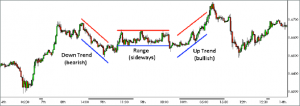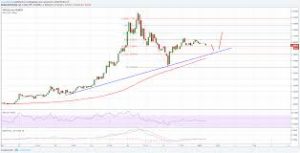
Bernard Baruch, “The Lone Wolf of Wall Street,” earned a seat on the New York Stock Exchange before turning 30. Furthermore, he became one of the most well-known financiers in the country by 1910. Although a master of his profession, Baruch didn’t have any illusions about the difficulties of prosperous stock market investing. According to him, the stock market’s main purpose is to make fools of as many men as possible. Ken Little, the author of 15 books on personal finance and investing, claims that every individual investor in the stock market should know that the system will always work in its own favor.
Still, hundreds of thousands of people are regularly buying and selling corporate securities on regulated stock exchanges or the NASDAQ. And some of them are actually successful. Luck isn’t the cause of a profitable outcome, but the utilization of some straightforward principles. These principles were developed from the experiences of millions of investors over countless stock market cycles.
Although intelligence is a great asset to whatever you do in life, it isn’t a necessary condition for investment success. A renowned Magellan Fund portfolio investor, Peter Lynch, said that everyone has enough mental ability to follow the stock market. According to him, everyone who can make it through fifth-grade math can do it.
Stock Market Investing Tips
People would love to find an easy and swift way to fortune and happiness. It is in our human nature to constantly look for a hidden key or a kind of arcane knowledge that will immediately lead us to the rainbow or result in winning the lottery.
Although it does occasionally happen that some people purchase winning lottery tickets or common stocks that quadruple in short periods of time, this is very unlikely. Only the most desperate or foolish ones would rely on luck as an investment strategy. When chasing success, we overlook some of the most powerful tools at our disposal: the magic of compounding interest and the power of time. If you invest regularly, avoid unnecessary financial risks, and let your money do the job for you over a period of a couple of years (and even decades), you will certainly collect significant assets.
Here are some tips that beginner investors should follow.
1. Set Long-Term Goals
What made you consider investing in the stock market? When will you need your money back? In six months, a year, or more than five years? What are you saving for? Is it for future college expenses, retirement, to buy a house, or do you maybe plan to build an estate?
Make sure that you know your purpose before investing. Also, you should know when you will need your money in the future. Those who might need their investment returned within the next couple of years should consider other types of investment. Volatile as it is, the stock market cannot provide any certainty. So, you might not be able to take your capital back when you need it.
If you know how much capital you will need, and when in the future you will need it, you can easily calculate the amount you should invest. Also, you should know what type of return on your investment will be required to put together the desired result. There are free financial calculators available online. They could help you estimate how much capital you will need for future college expenses or retirement.
You can find various retirement calculators at Bankrate, Kiplinger, and MSN Money. Depending on your needs, you can either use simple ones or more complex ones. For college cost estimates, use calculators available at TimeValue and CNNMoney. Numerous stock brokerage firms provide similar calculators.
There are three independent factors on which the growth of your portfolio depends upon:
- The capital you decide to invest
- The amount of net yearly earnings on your capital
- The number of years of your investment
It would be best to start saving sooner rather than later. Save as much as possible, and then receive the highest return you can, in accordance with your risk philosophy.
2. Know Your Personal Risk Tolerance
Risk tolerance is a genetically-based psychological trait, positively influenced by income, wealth, and education (your risk tolerance increases slightly as these increase) and negatively by your age (your risk tolerance decreases as you get older). Basically, it is what you think about taking risks, and how anxious you feel when there is risk present. Ask yourself to which extent you are willing to risk coming up against a less favorable outcome in the pursuit of a more favorable one. Would you be willing to risk $100 to win $1,000? Or $1,000 to win $1,000? People have different risk tolerance, so there is no “correct” balance.
Your perception of risk will also affect your risk tolerance. Back in the early 1900s, riding in a car or flying in an airplane was considered very risky. However, we don’t consider these things as risky today, since they are common occurrences. However, the majority of people today would feel that riding a horse could be dangerous. People would say there is a good chance one could fall or be bucked off. We think this way because we don’t spend a lot of time around horses anymore.
As you can see, perception is important, especially when it comes to investing. When you start learning more about investment – for example, how to buy and sell stocks, how much price change is usually present, and the ease or difficulty of liquidating an investment – you will probably realize that stock investments have less risk than you initially thought. Consequently, you will feel less anxious when investing, although your risk tolerance will be the same, as your risk perception has developed.
When you finally understand risk tolerance, you will be able to avoid investments that are probably going to make you anxious. In general, there is no point in owning an asset that will keep you up at night. Anxiety easily leads to fear, which then triggers various emotional responses (contrary to logical responses). If you can keep a cool head in periods of financial uncertainty and go through an analytical decision-making process, you will always come out ahead.
3. Manage Your Emotions
One’s lack of ability to control personal emotions and make objective decisions is the biggest obstacle to making stock market profits. Companies’ prices, in the short-term, reflect the emotions of the whole investment circle. When there’s a certain company that worries most investors, its stock price is bound to decline. And when the majority feels good about a company’s future, its stock price will probably rise.
We call someone who feels about the market in a negative way a “bear.” A “bull” is their positive counterpart. There is an ongoing battle between the bears and the bulls during market hours. This battle is reflected in the constant change of securities’ prices. All of these short-term movements are affected by emotions – speculations, rumors, and hopes. It is advised that you use logic – a systematic analysis of one’s company’s assets, prospects, and management.
When stock prices move contrary to our estimate, that creates insecurity and tension. One starts to wonder:”Should I sell to avoid loss? Will the price rebound and should I then keep the stock? Should I purchase more?”
Even when a stock price performs as you expected it, questions arise. Should one take the profit before the price falls again? As the price is likely to go even higher, should one keep their position? Such thoughts can overwhelm you, especially if you keep watching security prices, trying to decide if you should take action. But, bear in mind that when emotions drive your actions, you can easily be wrong.
Always have a good reason for buying a stock, as well as certain expectations regarding the price. Also, decide on a point at which you will put your holdings into liquidation, if the reason proves to be invalid, or the stock doesn’t perform as expected. Before you purchase the security and execute your strategy unemotionally, always have an exit strategy prepared.

4. Handle the Basics First
First things first – learn the basics of the stock market and that market’s individual securities before making your first investment. Remember the saying: ”It is a market of stocks, not a stock market.” So, your focus will be on individual securities, unless you are buying an ETF (exchange-traded fund). It rarely happens that every stock moves in the same direction. Sometimes the averages fall by a hundred points or more, and some companies’ securities go higher in price.
Here are the fields you should be familiar with before you make your first purchase:
- Different Kinds of Investment Accounts. Cash accounts are the most usual ones, but margin accounts might be required by law for some types of trades. Make sure that you know how to calculate margin and that you understand the difference between maintenance and initial margin requirements.
- Popular Methods of Timing and Stock Selection. It is vital that you know how technical and fundamental analyses are performed, what is the difference between them, and in which stock market strategy is each used.
- Financial Definitions and Metrics. Know the definitions of metrics. For example, the P/E ratio, return on equity (ROE), earnings per share (EPS), and compound annual growth rate (CAGR). Knowing how to calculate them and being able to compare various companies that use these metrics is crucial.
- Stock Market Order Types. Investors use various types of orders. For example, limit orders, market orders, stop limit orders, stop market orders, trailing stop loss orders, etc. You should be able to understand the difference between them.
Keep in mind that risk tolerance and knowledge are linked. According to Warren Buffett, risk comes from not knowing what you’re doing.
5. Diversify Investments
Buffett, as well as other experienced investors, avoids using stock diversification as they are confident that the research they performed is sufficient to recognize and quantify their risk. They believe they can spot potential dangers and put their investments into liquidation before facing terrible loss. Andrew Carnegie said:”The safest investment strategy is to put all of your eggs in one basket and watch that basket.” But be careful; you are neither Buffett nor Carnegie, especially in the beginner stage.
You can diversify your exposure in order to manage risk; it is one of the popular methods. Sensible investors have stocks of various companies in various industries, sometimes even in various countries. That is because they believe that an isolated unfortunate event won’t affect all of their holdings, or at least not to the same degree.
Think about this: you own stocks in five different companies, and you expect all of them to continually increase profits. However, circumstances change. When the year ends, two of your companies performed well, and their stocks grew by 25% each. Other two companies’ stocks in a different industry grew by 10% each. Finally, the fifth company’s assets were put into liquidation in order to pay off a huge lawsuit.
Diversification lets you recover from the loss of your entire investment. Imagine if you have invested solely in the fifth company; the outcome would have been much worse. This way, the value of your portfolio dropped by only 6%.
6. Stay Away from Leverage
When borrowed money is used to execute your stock market strategy, that is called leverage. If you use a margin account, you can take money from brokerage firms and banks to buy stocks, normally 50% of the purchase value. Simply put, if you want to buy 100 shares of a stock trading at $100 for a total cost of $10,000, a brokerage firm could give you $5000 for the purchase.
When you use the borrowed money, it “levers” or overemphasizes the result of price movement. Imagine owning a stock that moves to $200 a share which you decide to sell. The return would be 100% on your investment if you had used your own money. But, if you had borrowed $5,000 for the stock and sold it at $200 per share, the return would be 300% after you repay the loan and exclude the cost of interest paid to the bank or the broker.
That sounds great if the stock moves up. However, consider the other possibility. If your stock fell to $50 per share, then your loss would be 100%. You would lose your initial investment and have to pay the interest to the broker.
Leverage is neither good nor bad. It is a tool recommended to experienced investors who are confident in their abilities to make logical decisions. It is best to limit the risk at the beginning so that you can ensure profits in the long run.
Conclusion
In the course of history, equity investments have enjoyed significant returns, much more than other types of investments. Furthermore, they are easy to liquidate, and they have total visibility, as well as active regulation to make sure the same rules apply to everyone. If you are willing to consistently save, manage your risk appropriately, invest energy and time to gain experience, and be patient, investing in the stock market is a great chance to build large asset value. In order to achieve greater final results, it is better to start sooner rather than later. Keep in mind that you are a beginner; don’t skip any of the necessary steps.



































